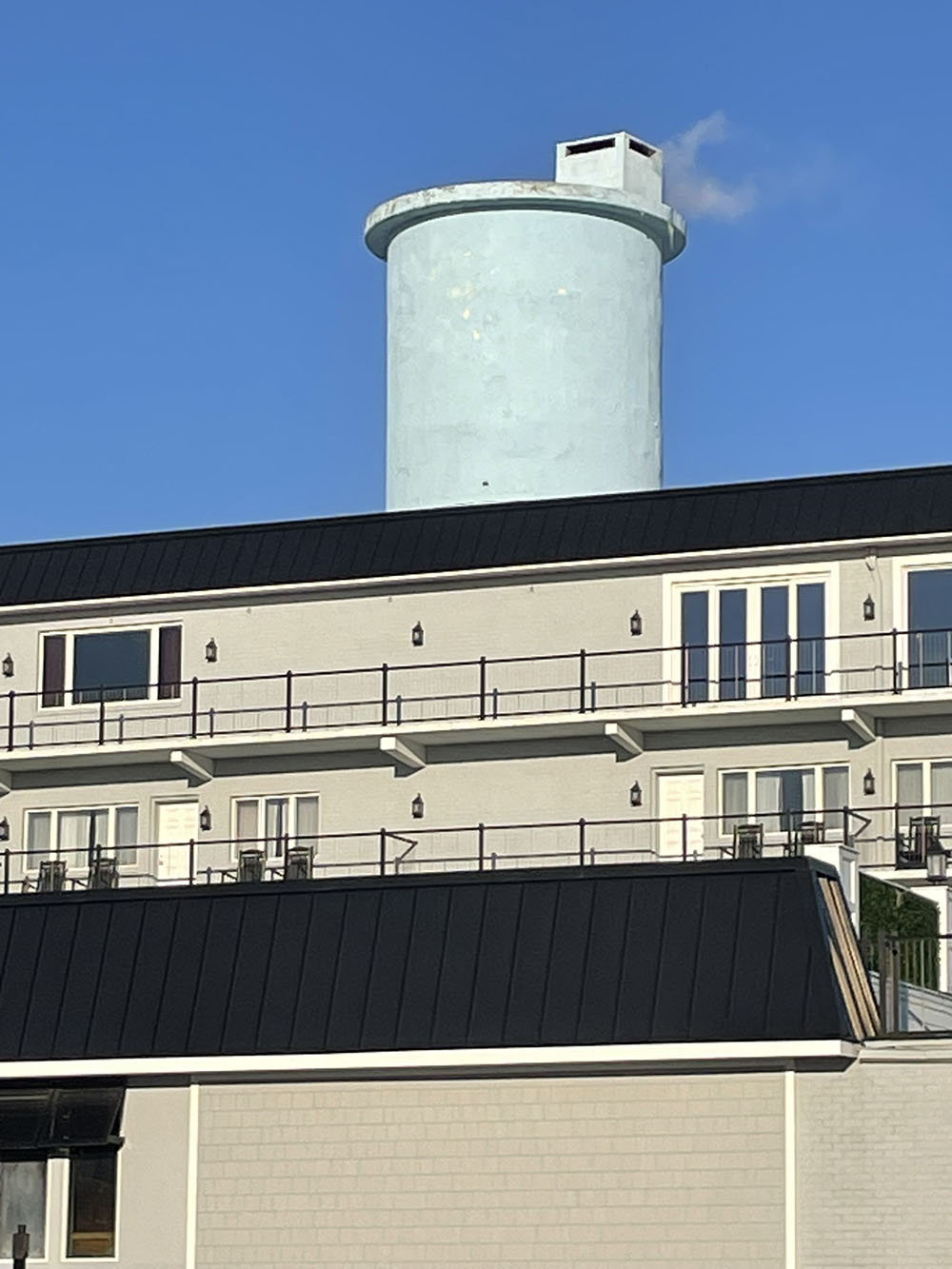Phil Courtney
Phil Courtney has been making art his whole life. These days, in his third-floor studio of his West Cape May house, he works on his own, having retired from painting and mounting billboards after more than 25 years. He has described his job as “Working on location at heights of 60 to 160 ft, using a scaled drawing as a guide, I painted images realistically for advertisements to be viewed from the passing automobile traffic on the highways below.”
Now, he stays on the ground, painting hyper-realistic seascapes, vegetables and fruit, flowers in bloom, clouds, and people, including a few self-portraits. He began showing his own work after moving to Cape May in 1995 with his wife and children. The Nature Center of Cape May featured Phil as their artist in residence for their annual fundraiser in 2019, Catch of Cape May.
After a brief tour through the house where many of his paintings hang, we climbed to the studio. In one corner stands the tall paint-spattered easel he uses when working in oils. On a wide table along one wall, he creates watercolors. When we met, that table held a glass bottle containing fading flowers, and a silver vase that had held the flowers as he painted his own vision of them. Lilies, holding their fragrance, and purple poppies flopped over the bottle, but stood sprightly and bright in the painting, a work in progress. Out the double window a series of rooflines formed their own picture, backed in the distance by bare trees and, finally, a strip of choppy ocean. It was a cold and windy day, a good time to be warm inside and look at a mural covering another wall, something completely different from Courtney’s usual work. It’s a group of nude Greek men in poses of strength. It’s a commission, something rare for the artist who usually just paints what he sees and likes.
Wait: billboards? Read on.
What inspires you? I look at your work and see the answer is Almost Everything.
Yeah. I say, ‘I’m gonna paint this,’ and then there are several factors: it’s a great composition; it will be a challenge. I really enjoy challenging myself. Sometimes I’ll say, ‘I’m not sure I can pull this off.’ Then I want to try it. I’d be bored unless I’m challenged; that’s why I keep changing subject matter. I’ll paint a series of flowers, and then I’ll get bored with that, and I’ll have to find something else.

I’m fond of your cabbages.
Some artists paint donuts, but I think I would eat them before I finished painting them.
When did you know that you were a really good artist and that you could pursue this?
I think probably junior high. I remember saying to myself, ‘do I really need to take all this and get good grades and all this other stuff? I’m gonna be an artist; I don’t need all this.’ And for a while I wasn’t doing very well in school because I thought ‘this is a waste of time.’ Then I realized—I do need good grades because an artist needs to know a lot about a lot. So, I changed my tune.
I used to draw constantly. In fact, I flunked third grade because I was drawing all the time in class. My parents took me to see a psychiatrist – like ‘what’s going on with this kid?’ and he said, ‘there’s nothing wrong with him [he just likes to draw].’
You ended up doing well in school and went to the Philadelphia Academy of Art. And with a prestigious degree in hand, you ended up painting billboards? Who knew that this was, in fact, an artist’s profession? How did it happen?
I’d moved to Philadelphia and lived there for many years, renovated a couple of houses there. [One day] I walked past the billboard company. The garage doors were open. I looked in and they were painting signs inside. I said, ‘I could do that,’ so I went in and looked at some billboards up close that were low to the ground, and I said, ‘I could do that.’ I applied for a job, and they said we’ll try you out. It was three blocks from my house, so I could walk to work. They painted the signs in their shop and took out pieces and hung them up. When I first started, I didn’t have to climb up.
I was doing that for a long time, and then the company bought another company in Atlantic City, and I convinced them I could work at the Atlantic City shop because then I could move to Cape May. That’s how I got here.
How does it feel to go 60 feet up in the air, hang onto that floating deck, and paint?
Not great! It didn’t make me dizzy, but I never liked it much. But it paid extremely well. Most of the time I painted in the factory studio. And they raised them up. Then I left that company, and I did have climb up signs after that. We would have a rope on either side of the stage and then pull it up and tie it off.
It was either that or teach. I had a degree to teach high school, but I student-taught and hated it. Also, I was just sick of being in the school environment.
But you teach now.
Whenever I want. I was teaching here at the house, but then I started getting concerned about liability. Now at the new Cape May Library there’s a double classroom. I’ve taught there twice and will do it again. I’m also going to teach in Rehoboth; they’ve got a great art league over there.
I looked at the watercolor painting lesson you did online, and the mix of colors, because you said clouds aren’t white. So, I looked and of course they’re not. What intrigued me was that you had these three pots of blues and greys and clear water. I looked and looked at clouds for blues and couldn’t find that color.
You have to get past what you think something is and then start thinking about what it really looks like. That’s what I’m teaching beginners.
You’d have to really study what you’re looking at.
I try to do that as much as I can. Not enough. But one of the reasons I paint in the studio a lot is I worked outside in billboards for a long time, and I like being inside now.
That’s what is interesting about an artist’s eye. That you automatically see things that the rest of us don’t see unless we’re told to look more carefully.
I give this example: When you drive through Cape May you see a certain number of things. When you ride your bike, you see a little more. If you’re walking around town, you see even more things. You might have lived here ten years, and say, “I never noticed that house.” But if you sit in one spot and paint something for two hours you see even more. Things just keep opening up.

But some of us must be told that, and some of us just know it.
I think some people are just built to look at the world differently. Everyone looks at the world differently – I just naturally started drawing and was interested in that.
You work a lot from photographs, but you also work from live settings.
Usually those paintings [from life] I do are not the same quality. I would say maybe one out of ten that I might sell. But it’s great practice to paint directly from life—really sharpens your eye.
You work on your own and you also get commissions, like the one on your wall here.
Yes. I don’t take many commissions, but I like working with these guys. They used to be Cape May people and moved to Palm Beach. So, it’s good to have a connection down there.
It’s so different from your other work. I would never have thought it was yours.
The first year at art school they have you draw from sculpture casts. I spent a whole year just drawing things like that. I finally got to take advantage of that training.
Tell us more about how you got here to Cape May.
When I first started doing billboards I was working 50 hours a week. I had young kids, so I pretty much stopped doing artwork for a while, because there was just no time. You get caught up in a career and raising a family – this takes a lot of time. [Doing art] takes a lot of time with prep work and execution.
We used to vacation in Cape May, and thought maybe we would want to retire here. So, when I had the opportunity to work in Atlantic City, we jumped on it. We almost went to the Point, but with young kids we thought it was isolated. This location came up and it was perfect, just outside the touristy area, but we could walk to town. We bought the house next door, which came with a vacant lot, so we designed this house, had it built, moved in, and sold that house.
We had to sell it because at that time billboard painting was starting to die. I ended up still working for the billboard company. [By that time] they’d invented printing on large vinyl canvas, and once that price matched our price, all the painting stopped. Then I started putting up this vinyl that replaced me. That was probably about 1991.
Were you doing your own work?
When the internet came along, people started advertising there, and billboards started to die. I started working four days a week, three days a week, sometimes two, so I had time to start painting again. At that time, I could afford not to take on another job. I was thinking about going into mural painting, but that was pretty hot back then, and I figured it was just a fad. It did last a bit longer than I thought, but then I just stuck with installing the vinyl signs. About three years ago I retired.
And now the roofs and trees and sky through his studio window keep Phil Courtney happily grounded.
Phil’s work will be shown at Cape May’s Jawbone Gallery on Carpenters Lane July 12–August 3, 2025.



